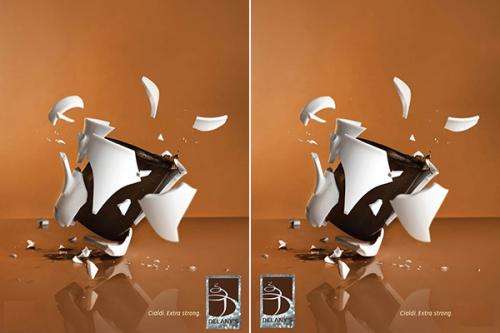Getting your attention: Study finds small changes in ads make them more memorable

(Phys.org)—Look at the two photos above—how many differences do you see? If you answered just one, you are correct. One is all marketers need to make you more likely to buy, according to new research by University of Delaware marketing professor Stewart Shapiro.
One change makes the same ad more memorable. Shapiro's new study in the Journal of Consumer Research argues that by subtly changing an ad that appears many times, you increase the likelihood consumers will remember the product.
"The question is, if you're a marketer, should you always run the exact same print ad, or should they run slightly different versions of it?" Shapiro said.
If you've seen an ad before, it may be cataloged and stored somewhere in your brain, even if you don't consciously realize it. When you see the same ad again, your brain recognizes it with little to no effort.
Shapiro and Nielsen contend that if something changes slightly in the ad—for instance, the location of the logo—your brain needs to devote more energy to it. While you are likely not aware of the extra effort, it helps cement the ad in your mind.
"You wonder 'why does this feels familiar to me?' People often times attribute that to the fact that they must like it," Shapiro said.
In search of proof, Shapiro, along with University of Arizona professor Jesper H. Nielsen, conducted some experiments. Participants were asked to watch as a series of nine print ads appeared on a computer screen. The loop ran four times. It contained three ads where the logo moved; the others remained constant. After some time passed, participants ranked their preferences on 12 ads (six from the show, six added as controls). Their response showed preference for the ads with the logo location change.
A subsequent similar experiment gave participants the option to choose a thank you gift for participating. Their selection contained three brands within the same product category (gum, marmalade, chocolate or shampoo). One brand choice was a control and two were from ads they had viewed; one ad remained the same while the other had a brand image location change. The products with the altered ads were 19 percent more likely to be chosen.
Shapiro notes this strategy seems to work best with low involvement products, items that consumers don't typically spend much time considering. Often these are inexpensive and disposable items such as candy.
Marketers' creativity may work against them in selling these low involvement products. Companies spend millions each year creating advertising campaigns where a theme is repeated in different ads. Shapiro's study contends that more might not be better. He says the impact created by slight changes disappears when too many elements of the ad are altered, as they are in campaigns.
More information: www.jstor.org/stable/info/10.1086/667852
Journal information: Journal of Consumer Research
Provided by University of Delaware















